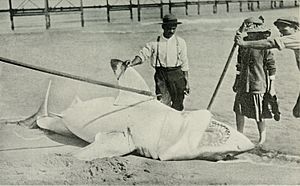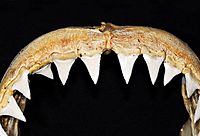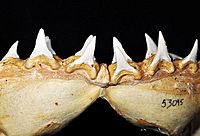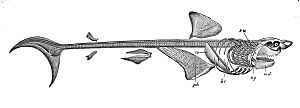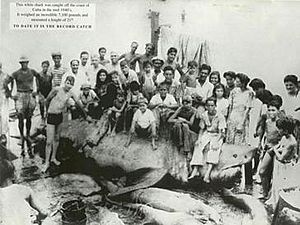Great white shark facts for kids
Quick facts for kids Great white shark |
|
|---|---|
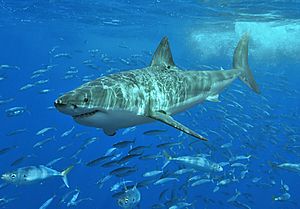 |
|
| Male off Isla Guadalupe, Mexico | |
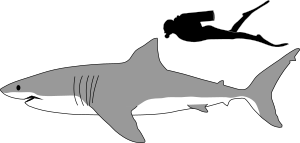 |
|
| Size comparison with human | |
| Conservation status | |
| Scientific classification | |
| Genus: |
Carcharodon
|
| Species: |
carcharias
|
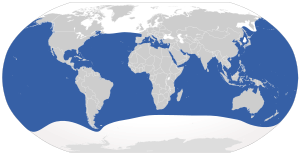 |
|
| Global range as of 2010 | |
The great white shark (Carcharodon carcharias) is a very large mackerel shark. It is also known as the white shark or white pointer. You can find these sharks in the coastal waters of all the world's major oceans.
Contents
- What's in a Name?
- Where Do Great White Sharks Live?
- What Does a Great White Shark Look Like?
- How Big Are Great White Sharks?
- Lifespan and Reproduction
- What Do Great White Sharks Eat?
- Who Hunts the Great White Shark?
- Amazing Adaptations of the Great White Shark
- Behavior and Social Life
- Great White Sharks and Humans
- Protecting Great White Sharks
- Great White Sharks in Popular Culture
- Interesting Facts About the Great White Shark
- Images for kids
- See also
What's in a Name?
The name 'white shark' probably comes from its bright white belly. This white underside is very easy to see when a shark is on a beach.
Where Do Great White Sharks Live?
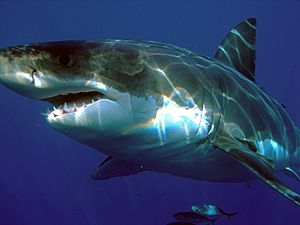
Great white sharks live in almost all coastal and offshore waters. They prefer water temperatures between 12 and 24 degrees Celsius (54 to 75 degrees Fahrenheit).
You can find them most often in the United States (Northeast and California), South Africa, Japan, Oceania, Chile, and the Mediterranean Sea. One of the largest groups lives around Dyer Island, South Africa.
Young great white sharks prefer slightly warmer, shallower waters. They stay in these "nurseries" where temperatures are between 14 and 24 degrees Celsius (57 to 75 degrees Fahrenheit). Scientists think that climate change might be making young sharks move towards the Earth's poles.
In the Northwest Atlantic, the number of white sharks dropped a lot due to too much fishing. But in recent years, their numbers have grown. This is mainly because the number of seals has increased in places like Cape Cod, Massachusetts.
A study in 2018 showed that white sharks like to gather deep inside warm-water ocean currents called eddies. They spend the daytime deep down and come closer to the surface at night.
What Does a Great White Shark Look Like?
The great white shark has a strong, large, cone-shaped snout. Its tail fin has two parts, called lobes, that are about the same size. This is similar to other mackerel sharks.
Great whites use a type of camouflage called countershading. Their belly is white, and their back is grey (sometimes brown or blue). This helps them blend in with the water from above and below.
Great White Shark Teeth
Great white sharks have rows of sharp, serrated teeth. If a tooth breaks off, another one from behind moves forward to replace it. When the shark bites, it shakes its head from side to side. This helps its teeth saw off large pieces of meat.
Great White Shark Eyes
Compared to their body size, great white sharks have bigger eyes than most other shark species. The colored part of their eye, called the iris, is a deep blue, not black.
How Big Are Great White Sharks?
Great white sharks are famous for their size. The largest female shark ever measured was 5.83 meters (19.1 feet) long. She weighed about 2,000 kilograms (4,400 pounds).
Most great white sharks are smaller than this. Males are usually 3.4 to 4 meters (11 to 13 feet) long. Females are typically 4.6 to 4.9 meters (15 to 16 feet) long.
Female great white sharks are generally larger than males. Adult sharks usually weigh between 522 and 771 kilograms (1,151 to 1,700 pounds). However, mature females can weigh between 680 and 1,110 kilograms (1,500 to 2,450 pounds) on average.
One of the largest great whites ever caught by a fisherman weighed 1,208 kilograms (2,663 pounds). This shark was caught in southern Australia in 1959.
Lifespan and Reproduction
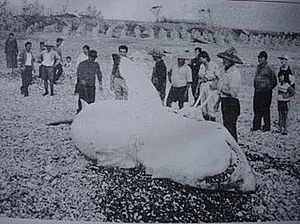
Great white sharks can live for a very long time, possibly 70 years or more! This makes them one of the longest-living fish with skeletons made of cartilage.
Male great white sharks become ready to have babies at about 26 years old. Females are ready at about 33 years old.
A mother shark carries her babies for 11 months. While inside the mother, the baby sharks eat eggs that the mother produces. This is called oophagy. Baby sharks are usually born in spring and summer. The most pups ever recorded from one mother was 14.
What Do Great White Sharks Eat?
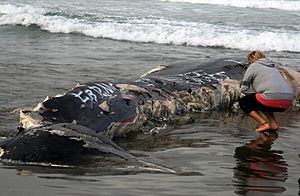
Great white sharks are carnivores, meaning they eat meat. They hunt and eat many different animals. These include fish like tuna and rays, other sharks, dolphins, porpoises, and whales. They also eat seals, sea lions, sea turtles, sea otters, and seabirds.
Sometimes, great whites eat things they cannot digest. Young white sharks mostly eat fish. Their jaws are not strong enough to attack larger prey like seals or whales until they are about 3 meters (10 feet) long. At this size, their jaw bones become strong enough.
When great white sharks grow to about 4 meters (13 feet) long, they start to hunt mostly marine mammals. However, some sharks seem to prefer different types of food.
Who Hunts the Great White Shark?
The great white shark has only one known natural predator: the orca, also known as the killer whale.
Amazing Adaptations of the Great White Shark
How Do Sharks Detect Things?
Great white sharks, like all sharks, have a special sense. They have tiny pores on their snout called ampullae of Lorenzini. These allow them to detect the tiny electrical fields that living animals create when they move.
Great whites are so sensitive that they can detect very, very small changes in electricity. This helps them find animals, even if they are not moving, by sensing their heartbeat. Most fish have a similar, but less developed, sense using their lateral line system.
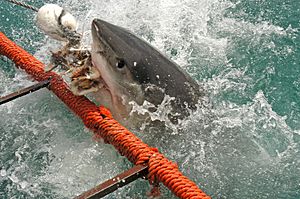
Can Great White Sharks Change Color?
In 2022, some research in South Africa suggested that great white sharks might be able to change their skin color. This could help them camouflage themselves. Different hormones might change their skin from white to grey. More research is needed to fully confirm this idea.
Behavior and Social Life
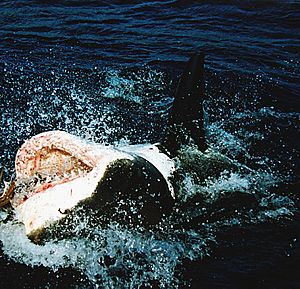
Great white sharks have complex behaviors and social rules. In South Africa, white sharks have a "pecking order" or dominance hierarchy. This means bigger sharks dominate smaller ones, females dominate males, and sharks that live in an area for a long time dominate newcomers.
When hunting, great whites usually spread out. They often avoid fighting by using special behaviors and displays. They rarely fight each other, but some sharks have bite marks from other great whites. This might mean they give warning bites if another shark gets too close. It could also be a way to show who is in charge.
Great white sharks are usually very curious animals. They are intelligent and can even be social when they need to be.
Amazing Breaching Behavior
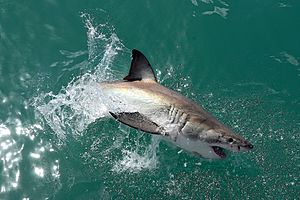
A "breach" happens when a great white shark swims very fast towards the surface. The force of its speed makes the shark jump partly or completely out of the water. This is a hunting technique they use to catch seals.
This behavior is often seen with cape fur seals at Seal Island in False Bay, South Africa. It's hard to film because it's so unpredictable. Scientists learned to use a fake seal towed behind a boat to trick the sharks into breaching.
Great white sharks can reach speeds of up to 40 kilometers per hour (25 mph). They can launch themselves more than 3 meters (10 feet) into the air! About half of these breach attacks are successful.
Great White Sharks and Humans
Shark Culling: Is it Good or Bad?
Shark culling is when a government purposely kills sharks to try and reduce shark attacks. This is sometimes called "shark control."
However, many environmentalists and scientists criticize these programs. They say that killing sharks harms the marine ecosystem (the ocean environment). They also believe these programs are "outdated, cruel, and ineffective."
Do Sharks Attack Boats?
Great white sharks sometimes bite boats, and in rare cases, they can even sink them. Only a few times have they bitten boats up to 10 meters (33 feet) long. They have also bumped boats or knocked people overboard, usually biting the back of the boat.
Scientists think sharks might be attracted to boats by the electrical fields they create. Sharks can sense these fields with their special pores, and it might confuse them into thinking there is wounded prey nearby.
Shark Tourism
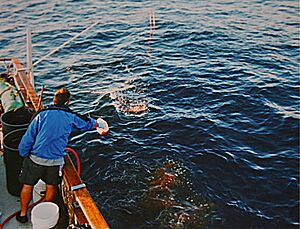
Shark cage diving is very popular in places where great whites are common. These include South Africa, the Neptune Islands in South Australia, and Guadalupe Island in Mexico. This has led to a growing tourism industry.
A common practice is to put "chum" (pieces of fish) in the water to attract sharks. Some people worry that this might make sharks get used to people and connect human activity with food. This could be dangerous.
Some tour operators pull bait on a wire towards the cage, which might make the shark hit the cage. Other operators pull the bait away from the cage, so the shark swims past the divers.
In some places, like Isla Guadalupe, using "hang baits" (bait hanging from a wire) is illegal. Responsible dive operators do not feed the sharks. They believe that if sharks don't find food at the end of a chum trail, they will soon swim away and not connect chum with a meal.
Protecting Great White Sharks
Fishermen often hunt many sharks for their jaws, teeth, and fins. However, the great white shark is rarely caught for commercial fishing, even though its meat is valuable.
Great white sharks face many challenges in the wild. Because of this, they are protected internationally. The International Union for Conservation of Nature (IUCN) lists the great white shark as a vulnerable species. This means their numbers are decreasing and they could become endangered.
It is very hard to keep great white sharks in captivity. They need to travel long distances and have a very specific diet. Because of this, no known aquariums in the world currently have a live great white shark.
Great White Sharks in Popular Culture
The great white shark is often shown in movies and books as a scary "man-eater." This is largely because of the famous novel Jaws and the movie based on it by Steven Spielberg.
However, humans are not a preferred food for great white sharks. While they are responsible for the most reported shark attacks on humans, these attacks are rare. They usually happen fewer than 10 times a year worldwide.
Interesting Facts About the Great White Shark
- It is the only living species in its genus Carcharodon.
- Great white sharks can swim up to 25 kilometers per hour (16 mph) in short bursts.
- They can dive to depths of 1,200 meters (3,900 feet).
- The great white shark is considered the world's largest predatory fish alive today.
- A great white shark can lift its head above the water to look at things, like prey. This is rare for sharks.
- Great white sharks store fat and oils in their livers. They use this energy for long journeys across the ocean.
- As of 2012, the great white shark was responsible for the most recorded shark bite incidents on humans, with 272 documented cases.
- A study in 2014 estimated that about 2,400 great white sharks live along the California coastline.
Images for kids
-
A shark scavenging on a whale carcass in False Bay, South Africa
-
Great white shark in the Monterey Bay Aquarium in September 2006
See also
 In Spanish: Tiburón blanco para niños
In Spanish: Tiburón blanco para niños
- List of sharks
- List of threatened sharks
- Outline of sharks
- Shark culling




